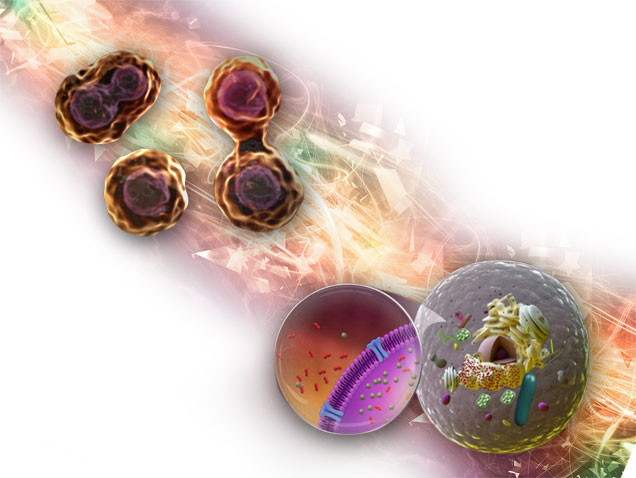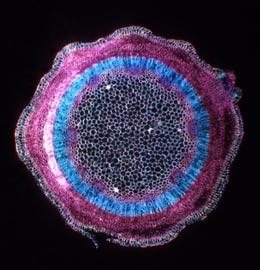 Every cell that multiplies and divides as the embryo develops knows what its task is and heads towards the relevant location in the body. Bone cells locate other bone cells and adhere to them, while eye cells bind to eye cells and other cells to others of their kind.
Every cell that multiplies and divides as the embryo develops knows what its task is and heads towards the relevant location in the body. Bone cells locate other bone cells and adhere to them, while eye cells bind to eye cells and other cells to others of their kind.
Let us now examine these statements with care.
Every cell that multiplies and divides knows what its task is. In these images you are looking at, you are seeing a fertilized egg multiply and divide. As the number of cells grows, cells begin grouping together. It is at this stage that the decision is taken as to what tasks these cells will undertake in the body. Some cells group together as muscle cells, others as nerve cells and others again as bone cells.
So how and why do these millions of constantly multiplying cells decide to become nerve, heart, muscle or liver cells?
Scientists discovered that cells use calcium in order to join together. They first combined and separated various embryonic cells in a laboratory environment by reducing the amount of calcium. The cells in this calcium-deprived environment could not combine together. They then added calcium to these cells and saw that cells of the same type recognized one another and joined together. In other words, all liver cells, heart cells, stomach cells and all the other types of cells recognize each other, come together and give rise to the relevant organ.
But how is it that these cells find one another, making no mistakes, and combine to create an organ?
Combination takes place in three stages; cell activation, mutual recognition and finally binding together.
Cell activation takes place with micro-protrusions which resemble fingers on the surface of the cell. By means of these protrusions, a bone cell moves along millions of developing cells and finds another bone cell to adhere to. But in order for a cell to move among millions of cells, the fluid inside the cell has to be of just the right thickness. If the fluid were a little bit thicker, the cell could not bear the resistance, and therefore could not move. That would make it impossible for cells to produce first a tissue and then later an organ.
THAT IS, IF CELLS DID NOT MOVE, our organs would not be formed.
 The answer to the question of how a liver cell recognizes another liver cell lies in the wondrous proteins on the cell membrane. Known as cadherins, these proteins first move toward the cell surface before binding takes place. They settle on the cell membrane and form a bridge between the inside of the cell and the outside. There are various types of cadherins. When two cells with the same cadherin molecules make contact, they recognize one another and binding begins. During the binding process, molecules on both the inside and outside of the cell become involved and establish a glorious cooperation together. The cadherin protein has the ability to bind to that part of the calcium remaining outside the cell. That is why calcium is one of the chemicals necessary for cells to bind to one another.
The answer to the question of how a liver cell recognizes another liver cell lies in the wondrous proteins on the cell membrane. Known as cadherins, these proteins first move toward the cell surface before binding takes place. They settle on the cell membrane and form a bridge between the inside of the cell and the outside. There are various types of cadherins. When two cells with the same cadherin molecules make contact, they recognize one another and binding begins. During the binding process, molecules on both the inside and outside of the cell become involved and establish a glorious cooperation together. The cadherin protein has the ability to bind to that part of the calcium remaining outside the cell. That is why calcium is one of the chemicals necessary for cells to bind to one another.
You are now seeing how nerve cells that recognize one another during embryonic development fold in on themselves after binding together. This takes place as cells with the same kind of cadherin bind together. When this process is over, all the nerve cells gather together in a single layer.
Two binding molecules use the force of attraction to join together. In order for a force of attraction to be established between cells, the distance between the two surfaces of the binding molecules has to be less than one nanometer and they have to be at the same level. While it is difficult for these conditions to be met the cells still manage to combine together because the force of attraction is capable of bearing a load of 40 nanograms; if the force of attraction between cells were not that strong, it would be impossible for one cell to bind to another. Allah has created this force attraction in such a sensitive manner that this bond permits both a very powerful binding force among cells as well as providing for a degree of flexibility, meaning it can be dissolved when necessary.
If our cells lacked this superb functioning that allows them to identify one another, we could not survive because in the event of any sickness, our red blood corpuscles would be unable to defend the body, our blood would not clot and, most important of all, the cells that give rise to our organs during embryonic development could not combine together.
This flawless functioning in our bodies is one of the manifestations of Allah’s glorious creative artistry.
I seek refuge in Allah from the satan;
Does not man recall that We created him before when he was not anything? (Surah Maryam, 67)


